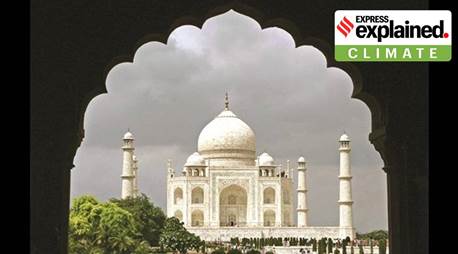Description

Copyright infringement not intended
Context:
The Supreme Court directed the Agra Development Authority to stop all commercial activities within a 500-metre radius of the Taj Mahal, a UNESCO World Heritage Site.
Details:
- The apex court has repeatedly called attention to the failures in protecting the Taj Mahal from various forms of pollution.
- In 2018, it had reprimanded the Centre and the UP government for its “apathy” and stated that the preserving of the Mughal-era structure was a “hopeless cause.”
- Since the 1970s, there have been growing concerns that emissions from industries near the Taj Mahal are causing its once-gleaming white marble surface to discolour, turning it yellow and black in some places. In order to protect the monument from pollution, the central government had demarcated an area of 10,400 sq km around the Taj, called the Taj Trapezium Zone (TTZ).
- Advocate and environmentalist M C Mehta had filed a petition before the Supreme Court in 1984, claiming that industries, foundries, vehicles and the nearby Mathura petroleum refinery were releasing toxic gases like sulphur dioxide, which were harmful to both the monument and the people in its vicinity. He therefore asked the court to take immediate measures to stop air pollution within the TTZ to protect the Taj Mahal.
- In 1996, the top court in a landmark judgement (M.C. Mehta vs Union Of India & Ors), stated that “the atmospheric pollution in TTZ has to be eliminated at any cost.”
- It found that the nearby coke/coal consuming industries were damaging the monument and the people living in the TTZ. It also directed the 292 industries operating in the zone to switch to natural gas as industrial-fuel, or relocate from their area.
- In 2010, a report submitted by the National Environmental Engineering Research Institute (NEERI) found that despite various government schemes to reduce pollution in the TTZ area, the iconic Taj Mahal continued to face a threat from water and air pollution.
- Although, between 1998 and 2000, the government had launched projects costing more than Rs 200 crore, the survey found that pollution levels in Agra continued to grow.
- While the creation of a bypass, improvements to the power supply and reduction of diesel generators had a positive impact, the study found that emissions of nitrogen oxide and particulates had reached higher levels than a decade prior, The Guardian reported in 2010.
- Furthermore, the NEERI report found that the Yamuna water, contaminated with industrial discharge, sewage and solid waste, was also damaging the monument as well.
- In July 2018, the top court condemned the “lethargy” shown by authorities in protecting the Taj Mahal.
- The Supreme Court had criticised the UP government for not producing a vision document that would outline the steps it would take to protect the monument, despite asking that it do so in December 2017.
- It had also questioned how the TTZ authorities were considering proposals by several industrialists to expand their units in the demarcated area, despite an “ad hoc Moratorium” imposed by the court.
- Earlier in 2018, the court had expressed concern over the changing colour of the Taj Mahal’s marble — from white, to yellowish, to brownish-green.
- Blaming the Archeological Survey of India (ASI) for its inability to protect the monument, the Supreme Court said that the ASI “will have to be thrown out of the picture” if the Taj Mahal was to be saved.
- Apart from harmful emissions from industries and vehicles, the Taj Mahal has also become discoloured due to contamination of the Yamuna, which has resulted in a loss of aquatic life, leading to insect and algae infestation of monuments situated on the river-bank.

About:
- The Mughal-era monument is protected by the Archaeological Survey of India
- The Taj Mahal was built by the Mughal emperor Shah Jahanas the tomb of his wife Mumtaz. The constriction of the marble monument began in 1632 and took 22 years to finally be completed in 1653.
- The architectural magnum opus was named a UNESCO World Heritage Sitein 1982.
https://indianexpress.com/article/explained/explained-climate/how-pollution-insects-are-threatening-taj-mahal-and-what-supreme-court-has-said-8176610/












